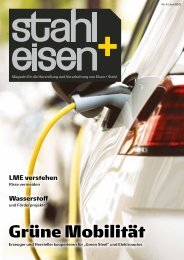stahl + eisen 03/2020 Leseprobe
SCHWERPUNKTE zum Relaunch: Dekarbonisierung * Metallurgie // WEITERE THEMEN: thyssenkrupp - Industrieikone im Umbruch, Zukunft von Stahlwerk Ilva bleibt ungewiss, Sentimentumfrage zu Corona-Virus, China - Zwischen Kohle und Kernkraft, Predictive Maintenance, Gesundheit am Arbeitsplatz
SCHWERPUNKTE zum Relaunch: Dekarbonisierung * Metallurgie // WEITERE THEMEN: thyssenkrupp - Industrieikone im Umbruch, Zukunft von Stahlwerk Ilva bleibt ungewiss, Sentimentumfrage zu Corona-Virus, China - Zwischen Kohle und Kernkraft, Predictive Maintenance, Gesundheit am Arbeitsplatz
Sie wollen auch ein ePaper? Erhöhen Sie die Reichweite Ihrer Titel.
YUMPU macht aus Druck-PDFs automatisch weboptimierte ePaper, die Google liebt.
■Economic return: potential for highly<br />
rfitable reer aluable etal<br />
(Cobalt, Nickel and Lithium)<br />
Social ■ impact: closing the loop with<br />
reuse of battery materials. Image promotion<br />
of the EV industry and brand recognition<br />
through engagement in battery<br />
recycling<br />
Supply ■ chain: without recycling, a shortage<br />
of supply in several key raw materials<br />
could be faced<br />
■Regulatory: market players are assigned<br />
or delegated with the responsibility of EV<br />
battery recycling by government regulations<br />
globally<br />
Sustainable: ■ closed loop economy enabled<br />
by innovative clean technology<br />
There are currently two dominant process<br />
routes for full processing / recycling<br />
of LIBs: hydrometallurgical and pyrometallurgical<br />
processes. The hydrometallurgical<br />
process consumes acidic / basic /<br />
industrial solvents, which are expensive<br />
and require additional processing to treat<br />
the toxic wastewater. It is also limited by<br />
a low reaction speed and a complicated<br />
process route. The pyrometallurgical<br />
process involves melting at high temperatures,<br />
which translates into high energy<br />
consumption (and cost), and high environmental<br />
emissions. The resulting<br />
extracted metal requires subsequent<br />
hydrometallurgical processing to further<br />
separate the products. 4<br />
The major drawbacks of current LIB<br />
recycling technologies can be summarized<br />
as a low product value from partial<br />
processing (physical separation) and a<br />
high operating cost for full processing<br />
(physical + chemical separation), which<br />
requires chemical conversion and metallurgical<br />
separation.<br />
The current high operating cost of<br />
the chemical separation processes naturally<br />
invites interest to develop a process<br />
that can avoid both the high temperature<br />
operations involving melting<br />
of metals or oxides, as well as the operating<br />
expenses associated with usage<br />
of solvent extraction (and to a degree<br />
hydrometallurgical altogether). 5 Given<br />
Total number of EVs in circulation globally<br />
(millions)<br />
160<br />
140<br />
120<br />
100<br />
80<br />
60<br />
40<br />
20<br />
0<br />
2018 <strong>2020</strong> 2025 2<strong>03</strong>0<br />
these unique design requirements, solid<br />
state processes involving conversion of<br />
elements of interest into desired forms<br />
in a solid solid or solid gas reaction regime<br />
become ideal candidates to achieve<br />
the required chemical separation in the<br />
EV LIB recycling exercise.<br />
One of the most notable and well<br />
developed solid state processes used in<br />
modern metallurgical operations is the<br />
production of Direct Reduced Iron (DRI)<br />
for use in steelmaking, which can shed<br />
much light on the design concept of a<br />
solid state process for EV LIB recycling.<br />
What can we learn from the<br />
production of DRI?<br />
DRI is produced from the direct reduction<br />
of iron ore (in the form of lumps,<br />
pellets, or fines into iron a reducing<br />
gas or elemental carbon produced from<br />
natural gas or coal. Many ores are suitable<br />
for direct reduction. Direct reduction<br />
processes can be broadly categorized<br />
into two categories: gas-based and coalbased.<br />
In both cases, the objective of the<br />
process is to remove the oxygen contained<br />
in various forms of ore, converting<br />
it to metallic form in solid state.<br />
The direct reduction process is comparativel<br />
energ efficient as no melting<br />
New EVs manufactured (millions)<br />
50<br />
45<br />
40<br />
35<br />
30<br />
25<br />
20<br />
15<br />
10<br />
5<br />
0<br />
2018 <strong>2020</strong> 2025 2<strong>03</strong>0<br />
RoW<br />
China<br />
is involved, with the reduction reactions<br />
taking place below the melting point of<br />
the metal in question (iron, in this case).<br />
Today, direct reduction processes have<br />
een developed to specificall overcome<br />
the difficulties of conventional last<br />
furnaces, the major production route<br />
for primary steel production worldwide.<br />
The initial capital investment and operating<br />
costs of direct reduction plants<br />
are generally lower than integrated steel<br />
plants and are more suitable in locations<br />
where supplies of high-grade coking<br />
coal are limited but steel scrap is<br />
generally available for recycling and<br />
charging at an electric arc furnace. In<br />
gas-based DRI processes, the charge<br />
mix is introduced into a cylindrical<br />
refractory-lined shaft furnace, where it<br />
descends gravit ow and is contacted<br />
upward owing reducing gas<br />
(hydrogen and carbon monoxide),<br />
which reacts with it to reduce the material<br />
prior to producing DRI for discharge.<br />
6<br />
In various forms of coal based DRI<br />
processes, the iron-bearing charge materials<br />
to the DR reactor consist of a<br />
miture of pellets andor lump ore, uxes<br />
such as limestone and/or dolomite<br />
and high volatile coal or lignite. There<br />
Spent LIBs<br />
Recycled<br />
battery metals<br />
~6 wt% Li<br />
~18 wt% Ni<br />
~18 wt% Co<br />
Physical<br />
Separation<br />
Black<br />
Mass<br />
XProEM Process<br />
~99,5 wt% Li<br />
~99,9 wt% Ni<br />
~99,9 wt% Co<br />
<strong>stahl</strong>und<strong>eisen</strong>.de März <strong>2020</strong> 49


















